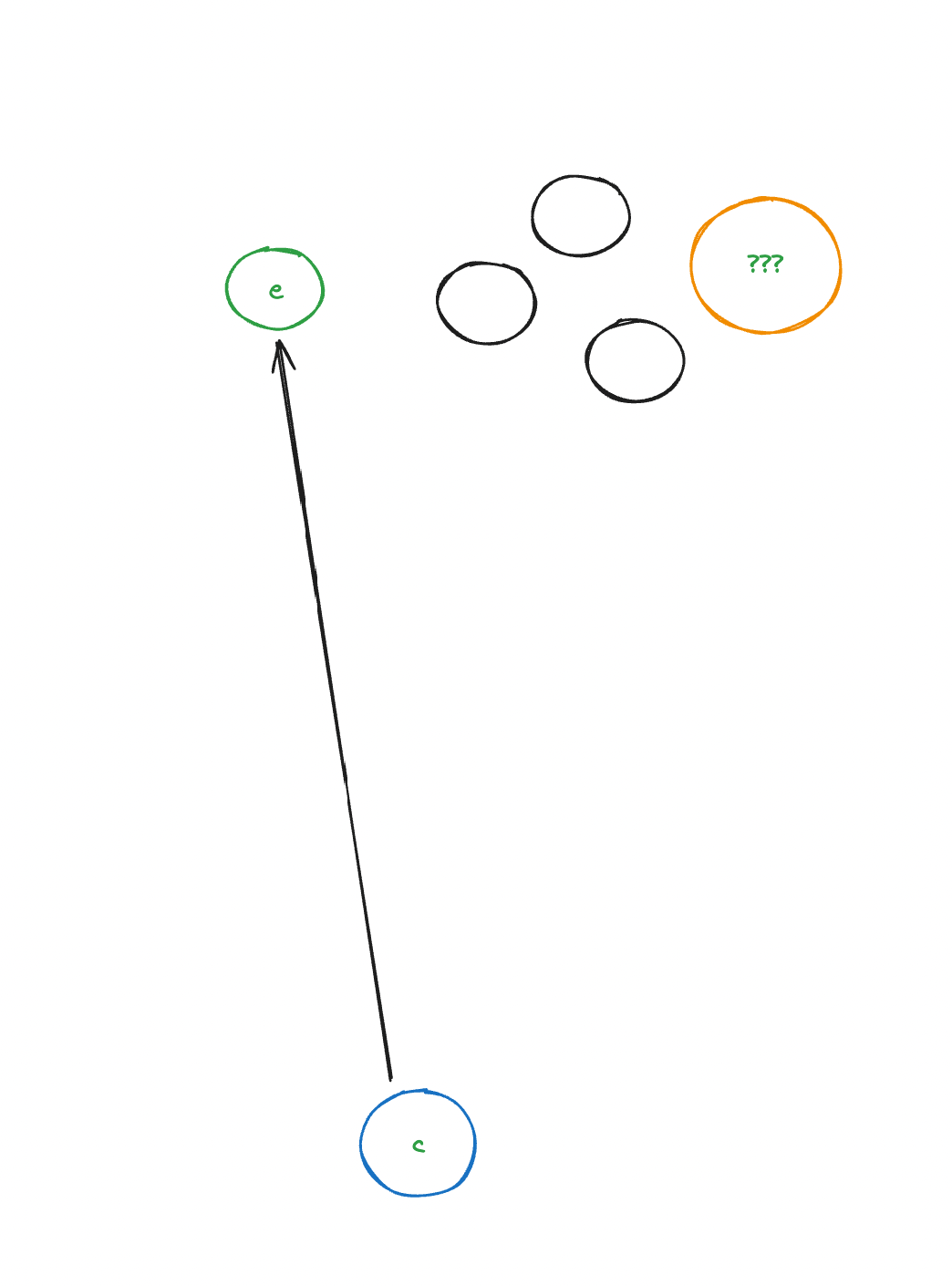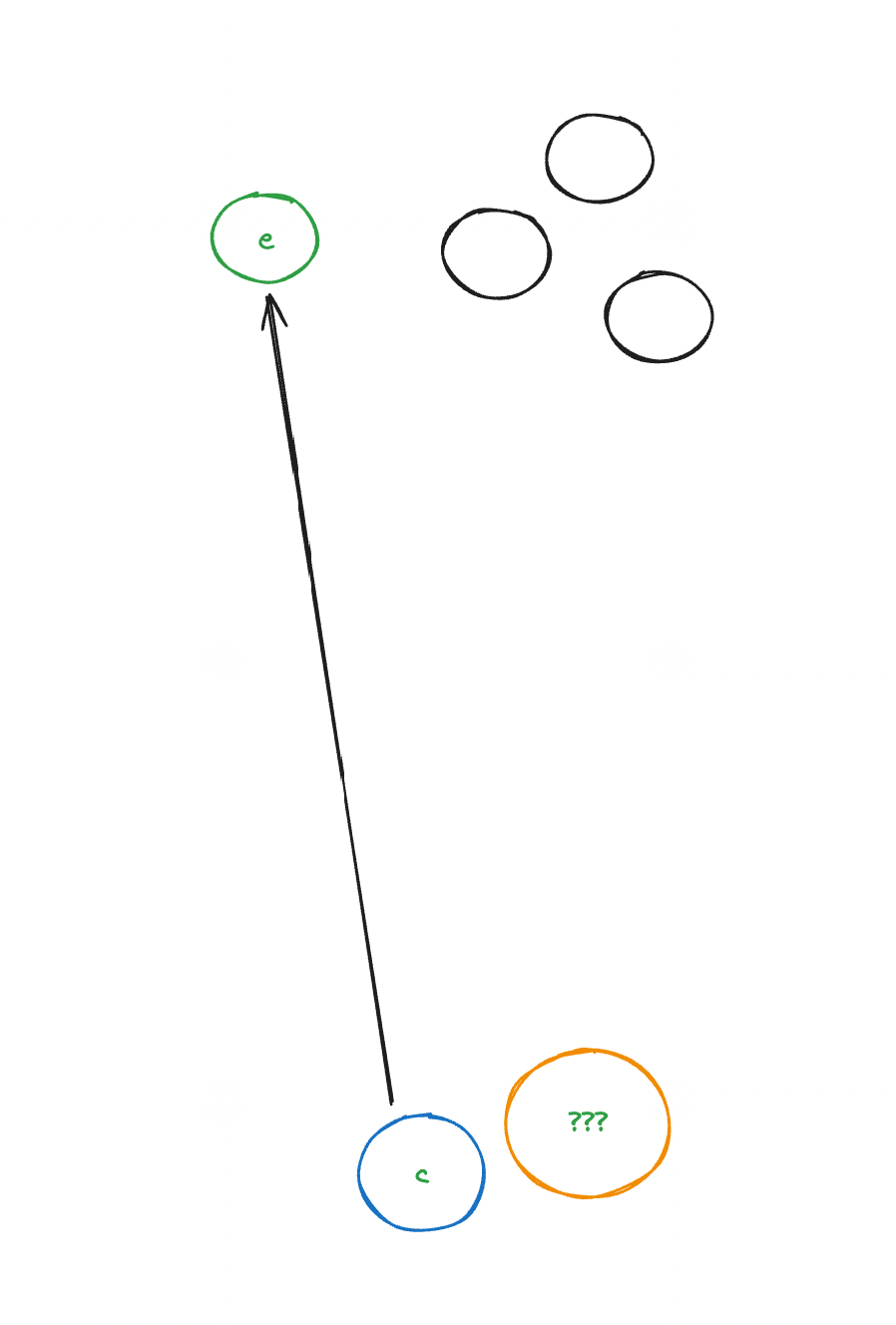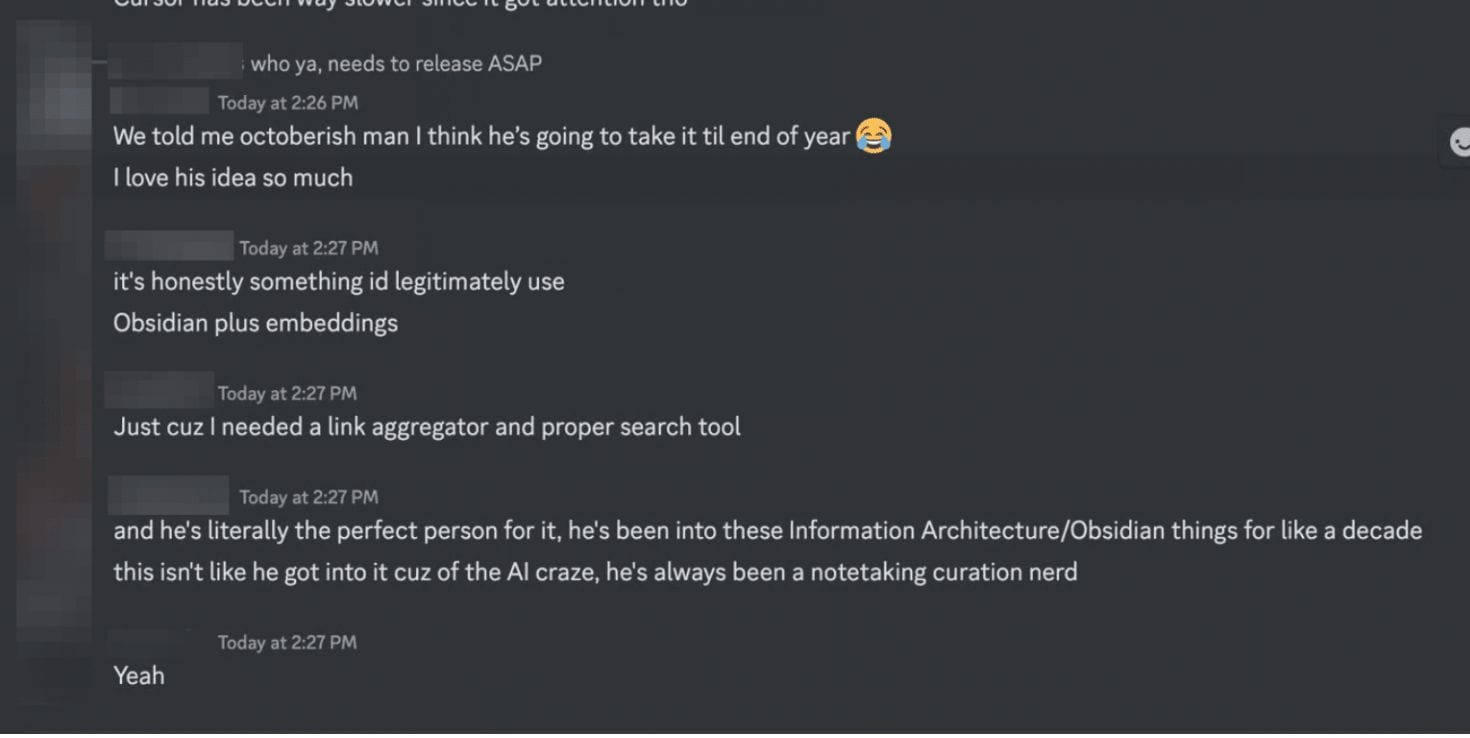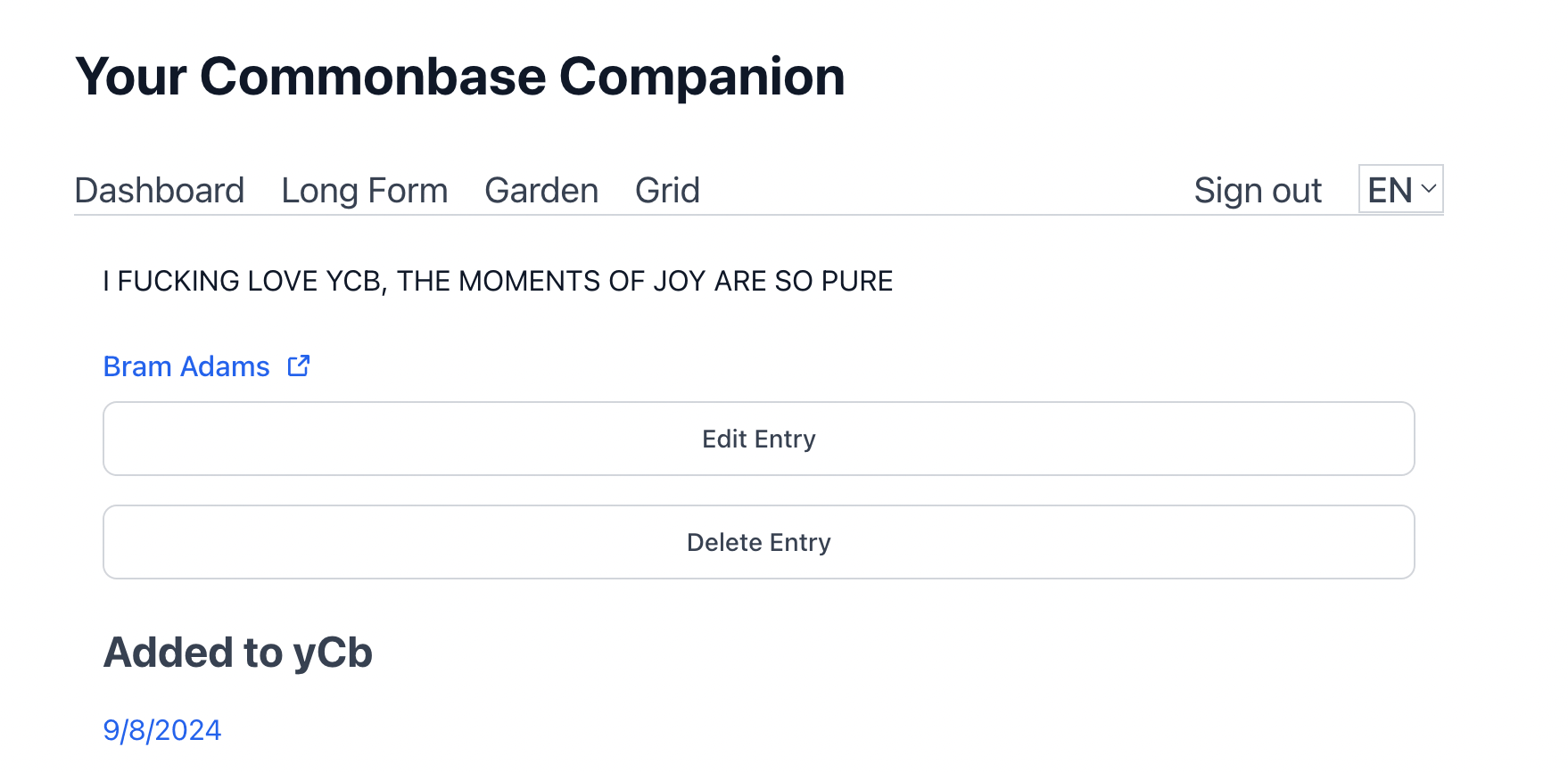Issue 57: Can You Back Into a Second Brain with a Collection of Software Features?
We're coming up on a launch, you see!

The fundamental problem of communication is that of reproducing at one point either exactly or approximately a message selected at another point. Frequently the messages have meaning.
— Claude Shannon (1948)
Dear Reader,
As I put the final touches on a v0 (v1? v1.5? – it depends on where you start counting I guess, if you go back to BHOV or Commonplace Bot) of Your Commonbase, I'd like to take a look back at some choices I've made. I find myself in a position where I need to justify why I've done what I did.
Software is an implementation after all, and philosophy can be brittle if not tested against the roughshod of reality.
So let's test it.
The Shape of The Problem
Why even bother with the effort of setting up a Second Brain? We don't even really know how our "first" brains work. We use our biological brains for everything, but we don't really know what they are. Wouldn't it be more effective to place our efforts there? To make the biological brain "perfect"?
If we hold up an internal mirror to the mind, we can roughly divine the shapes and curves of its abilities. How fast it moves in times of stress, its demand for caloric energy and hours of sleep, how far it can reach with creative associations (sometimes to the point of delusion), how quickly it can redefine itself when alone, amongst other people (peer pressure), or from a turn of phrase from some book – or how stubbornly it holds on to biases and ruminations.
It's like we are attempting to sketch a beast from the inside of the beast's mouth, while only being able to use the beast's mouth as a pencil. And as the paper too.
A second brain is – in it's entirety – an external tool. The beast uses its mouth to make a device that allows it to see the shadows that come off of the mouth, the shape of its teeth, the curvature of its lips. This could be a candle, a mirror, a memo pad, a computer, a library, a religion, a personal assistant, a invisible line drawn on stars in the sky. It doesn't matter.
By putting something out there – outside the mouth – paradoxically, the internal structures become more clear.
The purpose of a second brain is to both address the shortcomings of the first brain and to augment the capabilities of the first brain.
While seemingly similar, shortcomings stems from the problem of reality and augmentations stem from the problem of desire.
Shortcomings are more obvious than augmentations. An example of a shortcoming may be not being able to remember the name of a person you've met three times before, or not having enough mental horsepower to grasp a concept as it is being taught in a class where everyone else seems to just "get it".
Augmentations are more impactful, but less obvious. A shortcoming of the human body is to freeze in winter, so we invented shelter. But no one told you you had to put up a plasma TV in that shelter to entertain yourself at 1am or to paint the walls Dark Everglade Green. That is an augmentation. It has no immediate purpose but causes a phase shift in the possibilities.
A Second Brain needs to do both.
My Hypothesis
If we agree that externalized systems make a biological brain perform more effectively and efficiently, we can turn our attention to a much more soluble problem. Which is nice, because again, philosophy is just words after all.
So if systems == good, and there are a buffet of systems to choose from, it stands to reason that an optimal system == best.
In other words, some systems will be better than other systems.
So our task simply becomes to find that system and convert it into reality. Easier said than done, right?
A Successful Pre-Alpha
When my number of users =1 (me), my Second Brain system found near 100% capitalization rate. It did exactly what I needed it to do. It solved the task of my own mental shortcomings of memory and bandwidth, and augmented my creative work by showing me new capabilities, and helping secure my intellectual legacy through semantic search and smart databasing. All the effort I put into thinking was captured in my vaults, or my websites, or my programs, to be stored in the Halls of Information Valhalla.
Indeed, nearly all of the newsletters I've written for bramadams.dev, were direct beneficiaries of my work with my Second Brain. Book quotes, concepts, creative coding templates, all originated from the same trusted place.
The problem was when I tried to abstract those learnings to other people.
A Failed Alpha
I started with a Chrome Extension.
That's actually a lie, I started with a Discord Bot.
I started with a Discord Bot because I wanted to form a community around the experience that I was having. By leveraging a creative combination of Zettelkasten, vector embeddings, and a deep appreciation of the art of the written word, I had "transcended" my need for both tags and headings in my systems, while also being as chaotic as I wanted with the exploration of ideas I was curious to learn. I was able to glutton for memes, and while keeping my house clean at the same time.
I had created a system for collectors who hate clutter.
(As a side benefit, I was able to annoy my friends in group chats with barrages of book quotes whenever I desired.)
The Discord bot failed not because it didn't do what it was meant to do, but that it only did what it was meant to do. The shortcomings solved and the augmentations provided only made sense against my beast's mouth, one of many in a jungle filled with flora, and other hunters of different shapes and sizes.
I thought it might be as simple as providing people the same capabilities I had built into a Chrome Extension. I basically ported the lessons from the Discord bot one for one and then started inviting my friends to use it to build their own systems.
The usage patterns were pretty similar each time. A burst of initial use, a die off, and then a text like the following would hit my inbox ~a month after I had given them access to the Chrome Extension:



Basically, a good sentiment, but not enough real energy to convert said sentiment into action. If the system is as optimal as it was for n = 1, why couldn't I replicate?
A Successful Alpha
I don't want this essay to be technical, but you'll have to let me be technical for a moment.
The first alpha "failed" because I wasn't familiar with how people use tools in reality. I was more focused on augmentation than I was on shortcomings.
In the real world of data structures, people have already built habits around how things are currently done, instead of how they want them to be done.
In other words, people can't remember links due to the nature of URL encoded strings being ID based. This is because of how relational database store information and HTTP limits of encoded data. So that's a good place to start.
Companion is different than the extension because it uses its API to meet people where they are, with the needs they have.
The philosophies of Personal Library Science are burgeoned by the shape of the Internet as it is, and as people understand themselves.
The largest technical leaps I made with the current alpha over the first alpha were to:
- Make conscious importing easy (one click if possible)
- Make finding stuff easy (using semantic search)
Both of these technical changes address shortcomings, but allow for augmentation down the road.
Here's an example of image upload for (1):
Upload images to yCb directly from iOS! pic.twitter.com/E4eLfHIKa0
— bram adams (@_bramses) September 18, 2024
For (2), I'm using embedded comments as pointers to entries (a topic for another day). This makes searching both more reliable, more personal. The Second Brain addresses the shortcomings of software and language, in one fell swoop!
Vector embeddings can't read minds after all.


(left) a top 3 search misses our desired goal state (right) a comment with a pointer gives us our desired goal state [legend: ??? = search query, c = comment, e = entry]
The important thing, is that I'm letting in people more slowly and intentionally, and letting the blind spots of the software reveal themselves through patterns of use, while keeping my ears open for any step change opportunities for augmentation.
A strategy with two phases.
In this alpha, the usage patterns of my users have been much more consistent, and the feedback loops have been much more signal oriented.

A Hopefully Successful Launch
The core of Your Commonbase is effectively in place. And it's good. Real good. I'll let myself from September 8th, 2024 tell you himself:

The launch is coming up, you can sign up here if you want in when its ready.
Fingers crossed, I'll be able to host a small launch party here in NYC too, but that's not confirmed yet. – stay tuned if you're local.
Conclusion
The work is not done (I mean, just look at how I've been posting on Twitter, we're nowhere near done here lmao), but perhaps that's the point.
As the requirements of reality change, our technology changes to meet it. As our technology changes, our mental perception of our environment changes to meet that. And thus, our techniques for second brains must evolve in lock step. The brain is a physical object, and a second brain is abstract.
Thus, they dance!
Until next time.
Best,
Bram A.




